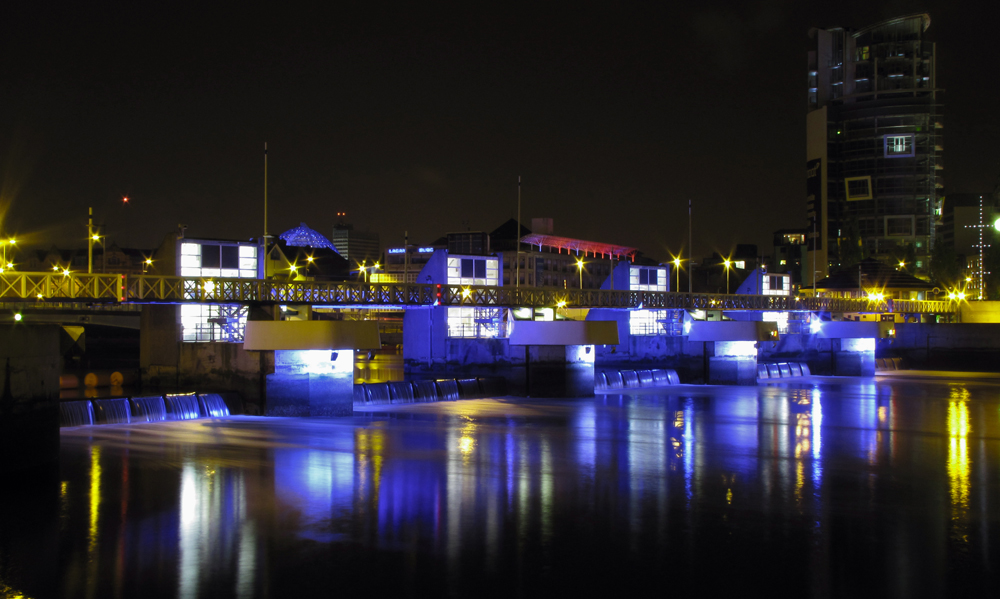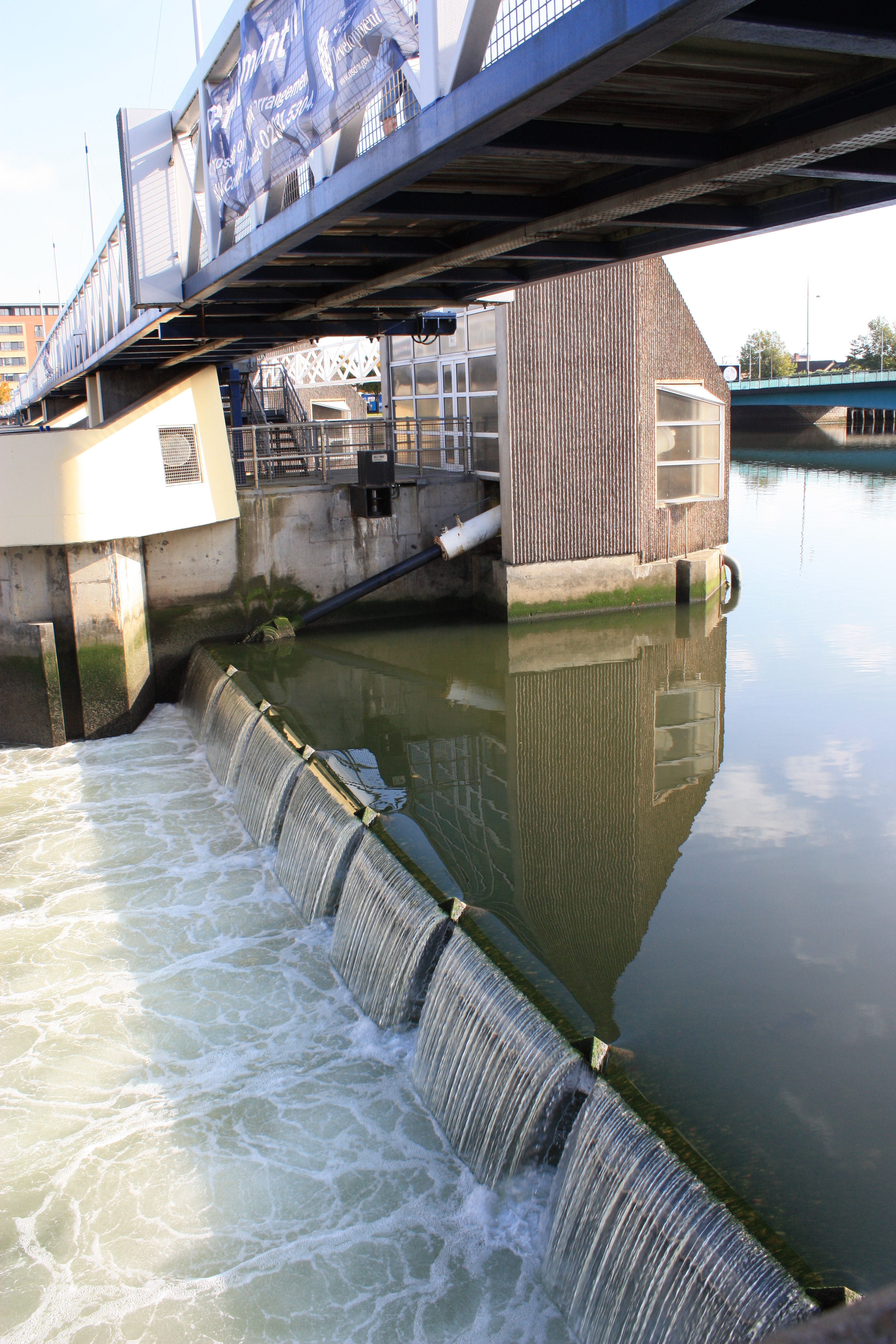Lagan Weir on:
[Wikipedia]
[Google]
[Amazon]


 The Lagan Weir, in
The Lagan Weir, in
Laganside Official Website
Photographs of the area
{{coord, 54.60086, N, 5.92000, W, source:placeopedia, display=title Buildings and structures in Belfast Transport in Belfast Weirs in Northern Ireland Bridges in Northern Ireland

Belfast
Belfast ( , ; from ga, Béal Feirste , meaning 'mouth of the sand-bank ford') is the capital and largest city of Northern Ireland, standing on the banks of the River Lagan on the east coast. It is the 12th-largest city in the United Kingdo ...
, Northern Ireland
Northern Ireland ( ga, Tuaisceart Éireann ; sco, label= Ulster-Scots, Norlin Airlann) is a part of the United Kingdom, situated in the north-east of the island of Ireland, that is variously described as a country, province or region. Nort ...
, crosses the River Lagan
The River Lagan (; Ulster Scots: ''Lagan Wattèr'') is a major river in Northern Ireland which runs 53.5 miles (86 km) from the Slieve Croob mountain in County Down to Belfast where it enters Belfast Lough, an inlet of the Irish Sea. The ...
between the Queen Elizabeth Bridge and the M3 cross-harbour bridge. Prior to the building of the weir, the river would be subject to tidal fluctuations, and low tide would expose mudflats, which were unsightly and emitted a strong odour, particularly in the summer months. Opened in 1994, the weir was seen by the Laganside Corporation
The Laganside Corporation was a non-departmental public body formed by the Laganside Development (Northern Ireland) Order 1989 with the goal of regenerating large sections of land in Belfast, Northern Ireland adjacent to the River Lagan. This ...
as a catalyst for its redevelopment projects and was judged to be the "centrepiece" of that effort. The weir also incorporates a footbridge.
Construction
The Lagan Weir, completed in 1994, is located inBelfast
Belfast ( , ; from ga, Béal Feirste , meaning 'mouth of the sand-bank ford') is the capital and largest city of Northern Ireland, standing on the banks of the River Lagan on the east coast. It is the 12th-largest city in the United Kingdo ...
, Northern Ireland
Northern Ireland ( ga, Tuaisceart Éireann ; sco, label= Ulster-Scots, Norlin Airlann) is a part of the United Kingdom, situated in the north-east of the island of Ireland, that is variously described as a country, province or region. Nort ...
and crosses the River Lagan
The River Lagan (; Ulster Scots: ''Lagan Wattèr'') is a major river in Northern Ireland which runs 53.5 miles (86 km) from the Slieve Croob mountain in County Down to Belfast where it enters Belfast Lough, an inlet of the Irish Sea. The ...
between the Queen Elizabeth Bridge and the M3 cross-harbour bridge. The £14m project was jointly funded by the Laganside Corporation
The Laganside Corporation was a non-departmental public body formed by the Laganside Development (Northern Ireland) Order 1989 with the goal of regenerating large sections of land in Belfast, Northern Ireland adjacent to the River Lagan. This ...
and the European Commission
The European Commission (EC) is the executive of the European Union (EU). It operates as a cabinet government, with 27 members of the Commission (informally known as "Commissioners") headed by a President. It includes an administrative body o ...
. It was designed by Ferguson and McIlveen and constructed by Charles Brand Ltd.
Planning for the weir commenced as early as 1988. The Prince of Wales
Prince of Wales ( cy, Tywysog Cymru, ; la, Princeps Cambriae/Walliae) is a title traditionally given to the heir apparent to the English and later British throne. Prior to the conquest by Edward I in the 13th century, it was used by the rulers ...
was involved in the ceremonial setting of the first pile for the weir on 7 March 1991. The floating crane
Floating may refer to:
* a type of dental work performed on horse teeth
* use of an isolation tank
* the guitar-playing technique where chords are sustained rather than scratched
* ''Floating'' (play), by Hugh Hughes
* Floating (psychological phe ...
''Mersey Mammoth'' lifted the five 32 tonne weir gates into position in May 1992. The weir gates measure 18 metres by 5 metres and were manufactured by Harland & Wolff
Harland & Wolff is a British shipbuilding company based in Belfast, Northern Ireland. It specialises in ship repair, shipbuilding and offshore construction. Harland & Wolff is famous for having built the majority of the ocean liners for the Wh ...
. The Weir was officially opened in March 1994.
The project included the "Lagan Lookout" on the Donegall Quay side of the river. This houses a visitors centre which has an exhibition to provide information on the function of the weir and the history of the River Lagan. The weir gate control centre, security, CCTV system and welfare facilities for River Management personnel are located on the ground floor. Equipment storage is located in the basement.
The Lagan Weir consists of five weir gates and four intermediate gatehouses. A tunnel traverses under the River Lagan, which connects to both quaysides and to each of the gatehouses. Primarily, this provides access to the gatehouses for maintaining the weir gate motors.
Weir operations
The five weir gates can each be operated independently. They are usually raised as the tide retreats in order to keep the river at a specific impoundment level. The gate operations are controlled by the River Manager. Without the weir, the river would be subject to tidal fluctuations. The tidal range is typically up to three metres between high and low tide, but the maximum tidal range can be as much as four metres. Prior to the building of the weir, low tide would expose mudflats, which were unsightly and emitted a strong odour, particularly in the summer months. On occasion, at high tide, the weir can operate as a barrage. If the river level is too high this can have such negative effects as causing erosion of the river banks, reduce air draft for vessels needing to pass under any of the river's road bridges and in extreme cases, increase the risk of flooding to low areas.Benefits
Construction of the weir, installation of an underwater aeration system and maintenance dredging has led to environmental improvements in terms of water quality and biodiversity. Dredging was carried out at the same time as the construction of the weir. Subsequent dredging was completed in 2010/2011 and 2019/2020. Development along the riverside has included construction of new residential towers, commercial and retail blocks, restaurants, and improved public towpaths.Footbridge
A pedestrian footbridge was constructed over the weir and connects Donegall Quay with Queen's Quay. The original bridge, which was narrow and required spiral access ramps at either end, was located above the weir gates and supported by the weir gatehouse structures. This was removed in 2014 to allow the construction a new structure, which provides access for both cyclists and pedestrians. The new bridge was erected by Graham Construction at a cost of £5m and is approximately 8 meters wide at its widest point.References
External links
Laganside Official Website
Photographs of the area
{{coord, 54.60086, N, 5.92000, W, source:placeopedia, display=title Buildings and structures in Belfast Transport in Belfast Weirs in Northern Ireland Bridges in Northern Ireland